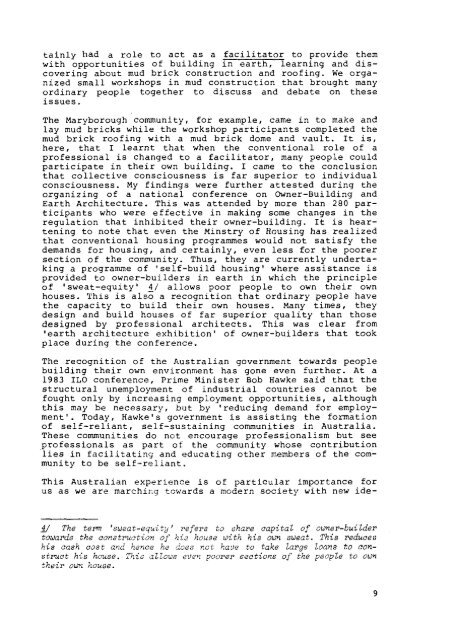Ifda dossier 47, May/June 1985
Ifda dossier 47, May/June 1985
Ifda dossier 47, May/June 1985
You also want an ePaper? Increase the reach of your titles
YUMPU automatically turns print PDFs into web optimized ePapers that Google loves.
tainly had a role to act as a facilitator to provide them<br />
with opportunities of building in earth, learning and dis-<br />
covering about mud brick construction and roofing. We orga-<br />
nized small workshops in mud construction that brought many<br />
ordinary people together to discuss and debate on these<br />
issues.<br />
The Maryborough community, for example, came in to make and<br />
lay mud bricks while the workshop participants completed the<br />
mud brick roofing with a mud brick dome and vault. It is,<br />
here, that I learnt that when the conventional role of a<br />
professional is changed to a facilitator, many people could<br />
participate in their own building. I came to the conclusion<br />
that collective consciousness is far superior to individual<br />
consciousness. My findings were further attested during the<br />
organizing of a national conference on Owner-Building and<br />
Earth Architecture. This was attended by more than 280 par-<br />
ticipants who were effective in making some changes in the<br />
regulation that inhibited their owner-building. It is hear-<br />
tening to note that even the Minstry of Housing has realized<br />
that conventional housing programmes would not satisfy the<br />
demands for housing, and certainly, even less for the poorer<br />
section of the community. Thus, they are currently underta-<br />
king a programme of 'self-build housing' where assistance is<br />
provided to owner-builders in earth in which the principle<br />
of 'sweat-equity' 4 / allows poor people to own their own<br />
houses. This is also a recognition that ordinary people have<br />
the capacity to build their own houses. Many times, they<br />
design and build houses of far superior quality than those<br />
designed by professional architects. This was clear from<br />
'earth architecture exhibition' of owner-builders that took<br />
place during the conference.<br />
The recognition of the Australian government towards people<br />
building their own environment has gone even further. At a<br />
1983 ILO conference, Prime Minister Bob Hawke said that the<br />
structural unemployment of industrial countries cannot be<br />
fought only by increasing employment opportunities, although<br />
this may be necessary, but by 'reducing demand for employ-<br />
ment'. Today, Hawke's government is assisting the formation<br />
of self-reliant, self-sustaining communities in Australia.<br />
These communities do not encourage professionalism but see<br />
professionals as part of the community whose contribution<br />
lies in facilitating and educating other members of the com-<br />
munity to be self-reliant.<br />
This Australian experience is of particular importance for<br />
us as we are marching towards a modern society with new ide-<br />
4J The term 'swat-equityf refers to share capital of owner-builder<br />
towards the oonstruovion of his house with his own sweat. This reduces<br />
his cash cost and hence he does not have to take large loans to con-<br />
struct his house. This atlous even poorer sections of the people to own<br />
their owi house.
















